Resilience Assessment in Distribution Grids: A Complete Simulation Model
Abstract
:1. Introduction
2. The Simulation Model
2.1. Risk and Resilience Indexes
2.2. Additional Indexes
- to evaluate the performances of a PDN under different threats;
- to compare performances of different PDNs;
- to identify the most suitable remedial actions in order to improve the network resilience.
2.3. RT Assessment
2.3.1. Ice Sleeve Formation
2.3.2. Heat Waves
- tower Substation—Type 1;
- undergrounded Substation—Type 2;
- pole Mounted Distribution Transformer—Type 3;
- prefabricated Substation—Type 4;
- building Undergrounded Substation—Type 5;
- box Substation—Type 6;
- raised Prefabricated Substation—Type 7.
- SF6 insulated MVP—Type 1;
- protected MVP—Type 2 (modular blocks designed for protecting lines and transformers, widely installed in distribution networks);
- air insulated MVP—Type 3.
2.3.3. Flooding
- Zone A: high hydrogeological risk, 50 years RT;
- Zone B: medium hydrogeological risk, 200 years RT;
- Zone C: low hydrogeological risk, 500 years RT;
- Zone D: no hydrogeological risk, RT = ∞.
- KV,F = 1 for underground substations, i.e., a flooding always cause the SS disconnection;
- KV,F = 0.75 for substations installed inside buildings, boxes, and prefabricated systems, i.e., a flooding may partially affect the SS;
- KV,F = 0 for the SSs raised off the ground, as in the case of pole mounted distribution transformers, i.e., the probability that a flooding causes the disconnection is null.
2.3.4. Tree Fall
- woods;
- agricultural areas;
- rows of trees;
- river parks;
- redevelopment areas.
- TCL for an overhead line in woods is equal to the real line length;
- TCL for an overhead line in agricultural areas is obtained by multiplying the line length by 0.3;
- TCL for an overhead line crossed by rows of trees is obtained by assigning to each tree crossing an equivalent length equal to 50 m;
- TCL for an overhead line in river parks is obtained by multiplying the length by 2;
- TCL for an overhead line in redevelopment areas is obtained by multiplying the length by 0.7;
- TCL for an overhead line outside the five areas is zero (i.e., urban areas).
2.4. Creation of Network Load Scenario
2.5. Selection of Reference Critical Scenarios
- three scenarios corresponding to the maximum loading of three different branches;
- one scenario corresponding to the maximum average loading of all the branches;
- one scenario corresponding to the minimum average loading of all the branches;
- one scenario corresponding to the maximum bus voltage;
- one scenario corresponding to the minimum bus voltage;
- one scenario corresponding to the maximum voltage variance of all buses;
- one scenario randomly selected amongst the remaining quarter hour scenarios.
2.6. Resilience Assessment Procedure
- Ice sleeves: branches representing MV overhead lines; nodes representing interconnections with HV network; nodes representing interconnections with other MV networks.
- Heat waves: nodes representing the MV busbars of the SSs.
- Floodings: nodes representing the MV busbars of the SSs.
- Tree fall: branches representing MV overhead lines.
3. Results
3.1. PDN under Study
- thirty-one MWp photovoltaic plants, producing about 36 GWh yearly;
- seven Hydro plants for an aggregate 10 MW power, producing about 68 GWh yearly;
- four biomass/waste to energy plants for an aggregate 20 MW power, producing about 78 GWh yearly.
3.2. Numerical Application: PDN Resilience against Tree Fall
4. Conclusions
- Resilience assessment has to account load profiles and network constraints, in order to avoid an underestimation of the number of buses and users disconnected due to a contingency.
- The above-mentioned underestimation is more accentuated in portions of the distribution network with a meshed configuration, whereas it is negligible in portions of the network with branches in the antenna.
- Network reconfiguration may be ineffective both for the resilience assessment and for the choice of corrective actions improving resilience, if network constraints are not taken into account.
Author Contributions
Funding
Institutional Review Board Statement
Informed Consent Statement
Data Availability Statement
Conflicts of Interest
Nomenclature
| PDN | Power distribution network |
| HV | High voltage |
| DSO | Distribution system operator |
| MV | Medium voltage |
| LV | Low voltage |
| RT | Return time of a network asset |
| RTeq | Equivalent return time of a network asset |
| PS | Primary substation |
| SS | Secondary substation |
| NUD | Number of users disconnected |
| TSO | Transmission system operator |
| TX3X | 3-day-mean area-averaged daily maximum temperature |
| MVP | Medium voltage panel |
| TCL | Tree covered length |
| ATCL | Aggregate tree covered length |
References
- Zio, E. Challenges in the vulnerability and risk analysis of critical infrastructures. Rel. Eng. Syst. Saf. 2016, 152, 137–150. [Google Scholar] [CrossRef]
- Transmission and Distribution Committee of the IEEE Power & Energy Society. Guide for electric power distribution reliability indices. In IEEE Standard 1366; Transmission and Distribution Committee of the IEEE Power & Energy Society: Piscataway, MJ, USA, 2012. [Google Scholar]
- Hosseini, S.; Barker, K.; Ramirez-Marquez, J.E. A review of definitions and measures of system resilience. Rel. Eng. Syst. Saf. 2016, 145, 47–61. [Google Scholar] [CrossRef]
- Kwasinski, A. Quantitative model and metrics of electrical grids resilience evaluated at a power distribution level. Energies 2016, 9, 93. [Google Scholar] [CrossRef]
- Fu, G.; Wilkinson, S.; Dawson, R.J.; Fowler, H.J.; Kilsby, C.; Panteli, M.; Mancarella, P. Integrated approach to assess the resilience of future electricity infrastructure networks to climate hazards. IEEE Syst. J. 2018, 12, 3169–3180. [Google Scholar] [CrossRef] [Green Version]
- Kim, D.H.; Eisenberg, D.A.; Chun, Y.H.; Park, J. Network topology and resilience analysis of South Korean power grid. Phys. A Stat. Mech. Its Appl. 2017, 465, 13–24. [Google Scholar] [CrossRef] [Green Version]
- Chanda, S.; Srivastava, A.K. Defining and enabling resiliency of electric distribution systems with multiple microgrids. IEEE Trans. Smart Grid 2016, 7, 2859–2868. [Google Scholar] [CrossRef]
- Ouyang, M.; Duenas-Osorio, L. Time-dependent resilience assessment and improvement of urban infrastructure systems. Chaos Interdiscip. J. Nonlinear Sci. 2012, 22, 033122. [Google Scholar] [CrossRef] [PubMed] [Green Version]
- Bessani, M.; Massignan, J.A.D.; Fanucchi, R.Z.; Camillo, M.H.M.; London, J.B.A.; Delbem, A.C.B.; Maciel, C.D. Probabilistic assessment of power distribution systems resilience under extreme weather. IEEE Syst. J. 2019, 13, 1747–1756. [Google Scholar] [CrossRef]
- Maliszewski, P.J.; Perrings, C. Factors in the resilience of electrical power distribution infrastructures. Appl. Geogr. 2012, 32, 668–679. [Google Scholar] [CrossRef]
- Bie, Z.; Lin, Y.; Li, G.; Li, F. Battling the extreme: A study on the power system resilience. Proc. IEEE 2017, 105, 1253–1266. [Google Scholar] [CrossRef]
- Presidential Policy Directive—Critical Infrastructure Security and Resilience. Available online: https://www.whitehouse.gov/the-press-office/2013/02/12/presidential-policy-directive-critical-infrastructure-security-and-resil (accessed on 10 May 2021).
- Sector Resilience Report; Office of Cyber and Infrastructure Analysis (OCIA), National Protection and Programs Directorate, Infrastructure Sector Assessment, Department of Homeland Security: Washington, DC, USA, 2014.
- U.S. Department of Commerce; National Institute of Standards and Technology. Community Resilience Planning Guide. 2015. Available online: http://www.nist.gov/el/building_materials/resilience/guide.cfm (accessed on 10 May 2021).
- Watson, J.P.; Guttromson, R.; Silva-Monroy, C.; Jeffers, R.; Jones, K.; Ellison, J.; Rath, C.; Gearhart, J.; Jones, D.; Corbet, T.; et al. Conceptual Framework for Developing Resilience Metrics for the Electricity, Oil, and Gas Sectors in the United States; SAND2014-18019; Sandia National Laboratory: Albuquerque, NM, USA, 2014. [Google Scholar]
- European Network and Information Security Agency (ENISA). Measurement Frameworks and Metrics for Resilient Networks and Services: Challenges and Recommendations; ENISA: Heraklion, Greece, 2010. [Google Scholar]
- ARERA. Available online: https://www.arera.it/it/inglese/index.htm (accessed on 10 May 2021).
- Linee Guida Per la Presentazione Dei Piani di Lavoro Per L’incremento Della Resilienza Del Sistema Elettrico (in Italian). Available online: https://www.arera.it/allegati/docs/17/002-17dieu_alla.pdf (accessed on 10 May 2021).
- Amicarelli, E.; Ferri, L.; De Masi, M.; Suich, A.; Valtorta, G. Assessment of the Resilience of the Electrical Distribution Grid: E-distribuzione Approach. In Proceedings of the AEIT International Conference, Bari, Italy, 3–5 October 2018. [Google Scholar]
- Bragatto, T.; Cresta, M.; Gatta, F.M.; Geri, A.; Maccioni, M.; Paulucci, M. Assessment and Possible Solution to Increase the Resilience of Terni Distribution Grid: The Ice Sleeves Formation Threat. In Proceedings of the AEIT International Conference, Bari, Italy, 3–5 October 2018. [Google Scholar]
- Bragatto, T.; Cortesi, F.; Cresta, M.; Gatta, F.M.; Geri, A.; Maccioni, M.; Paulucci, M. Assessment and possible solution to increase resilience: Flooding threats in Terni distribution grid. Energies 2019, 12, 744. [Google Scholar] [CrossRef] [Green Version]
- Bragatto, T.; Cortesi, F.; Cresta, M.; Gatta, F.M.; Geri, A.; Maccioni, M.; Paulucci, M. Assessment and Possible Solution to Increase Resilience: Heat Waves in Terni Distribution Grid. In Proceedings of the AEIT International Conference, Florence, Italy, 18–20 September 2019. [Google Scholar]
- Cresta, M.; Gatta, F.M.; Geri, A.; Maccioni, M.; Paulucci, M.; Rizzo, A. Resilience Assessment in TDE’s Distribution Grid: Risk Model for Tree Falls. In Proceedings of the AEIT International Conference, Catania, Italy, 23–25 September 2020. [Google Scholar]
- Linkov, I.; Trump, B.D. The Science and Practice of Resilience, 1st ed.; Springer Nature Switzerland AG: Cham, Switzerland, 2019; pp. 79–101. [Google Scholar]
- EN Std. 50341-1. Overhead Electrical Lines Exceeding AC 1 kV. General Requirements. Common Specifications; CENELEC: Brussels, Belgium, 2013. [Google Scholar]
- EN Std. 50341-2-13. Overhead Electrical Lines Exceeding AC 1 kV. National Normative Aspects (NNA) for ITALY; CEI: Milan, Italy, 2017. [Google Scholar]
- Gumbel, E.J. Statistics of Extremes, 1st ed.; Columbia University Press: New York, NY, USA, 1958. [Google Scholar]
- Kew, S.F.; Philip, S.Y.; Van Oldenborgh, G.J.; Otto, F.E.L.; Vautard, R.; Van Der Schrier, G. The exceptional summer heat wave in Southern Europe 2017. Bull. Am. Meteorol. Soc. 2019, 100, 49–53. [Google Scholar] [CrossRef]
- Province of Terni, Office of Civil Protection. Emergency Plan of the Province, Hydro Risk (In Italian). Available online: http://cms.provincia.terni.it/on-line/Home/Areetematiche/Protezionecivile/Pianidiemergenzaprovinciale/RischioIdrogeologico/articolo7447.html (accessed on 10 May 2021).
- Authority of Tiber Basin, Hydrogeological Plan, Technical Standards (In Italian). Available online: http://www.abtevere.it/node/88 (accessed on 10 May 2021).
- Dunn, S.; Wilkinson, S.; Alderson, D.; Fowler, H.; Galasso, C. Fragility curves for assessing the resilience of electricity networks constructed from an extensive fault database. Nat. Hazards Rev. 2018, 19, 04017019. [Google Scholar] [CrossRef] [Green Version]
- Heinimann, H.R.; Hatfield, K. Infrastructure Resilience Assessment, Management and Governance—State and Perspectives. In Resilience and Risk: Methods and Application in Environment, Cyber and Social Domains, 1st ed.; Linkov, I., Palma-Oliveira, J.M., Eds.; Springer: Dordrecht, The Netherlands, 2017; pp. 147–187. [Google Scholar]
- Zimmerman, R.D.; Murillo-Sanchez, C.E.; Thomas, R.J. MATPOWER: Steady-state operations, planning, and analysis tools for power systems research and education. IEEE Trans. Power Syst. 2011, 26, 12–19. [Google Scholar] [CrossRef] [Green Version]
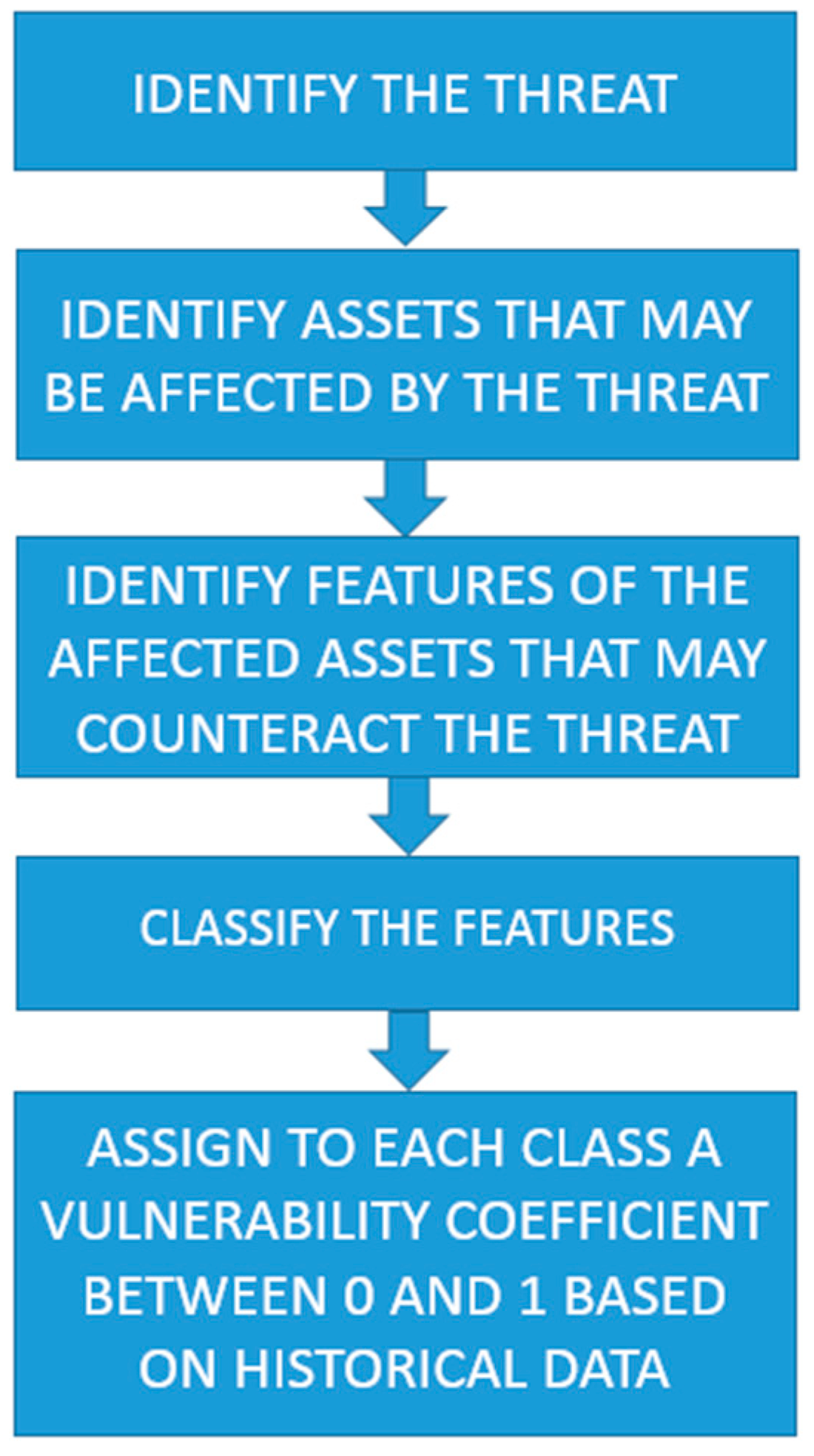

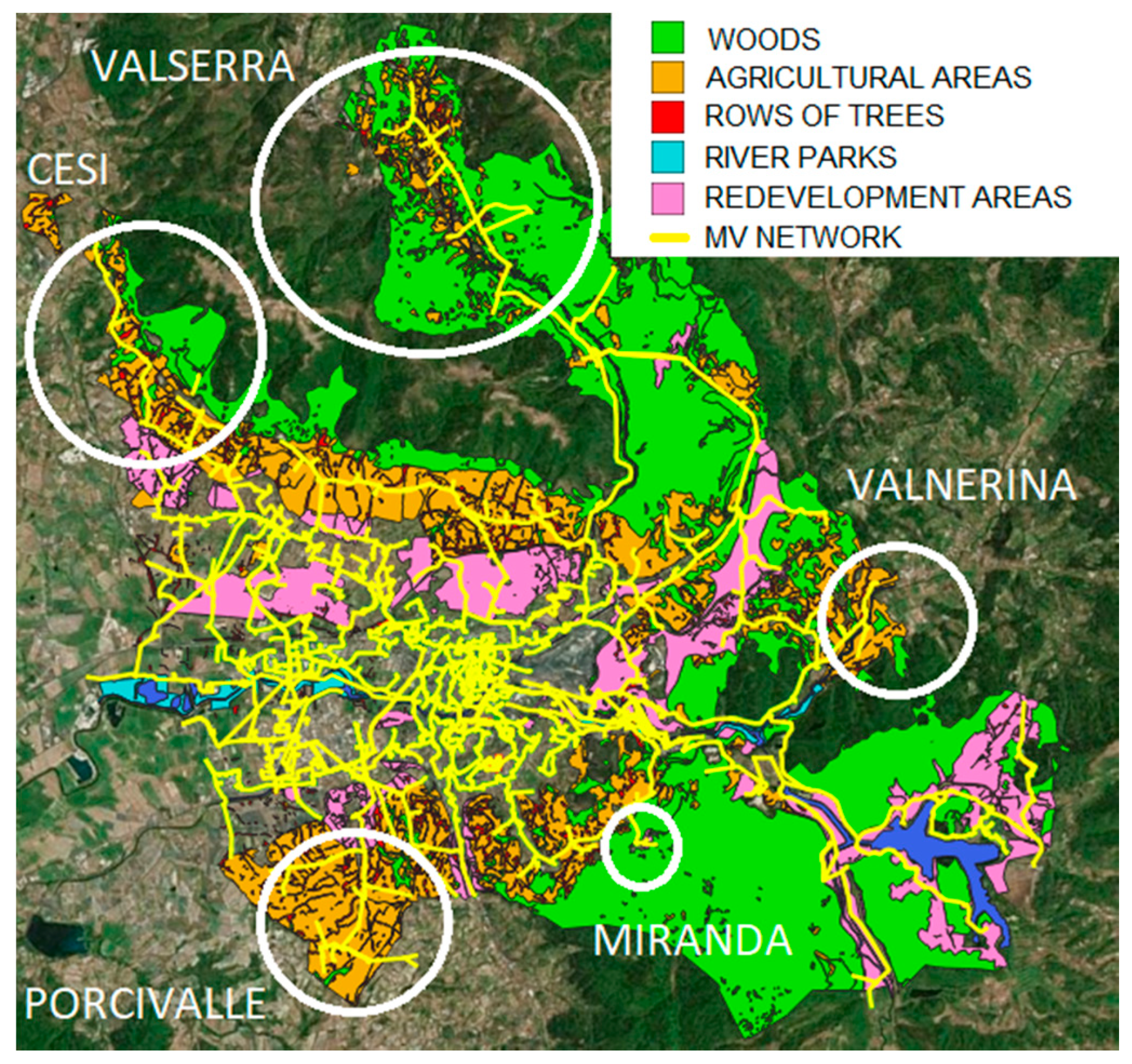
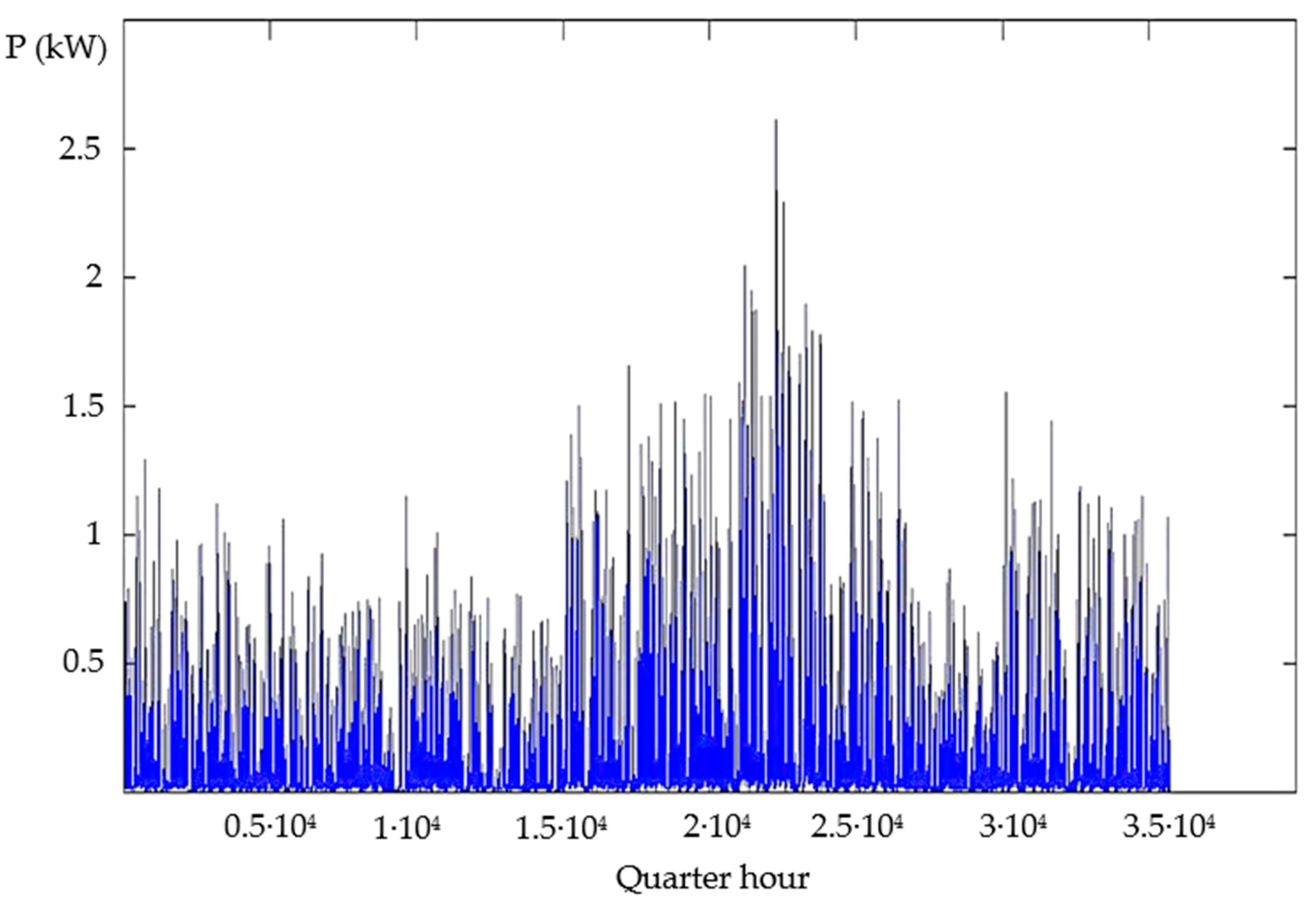
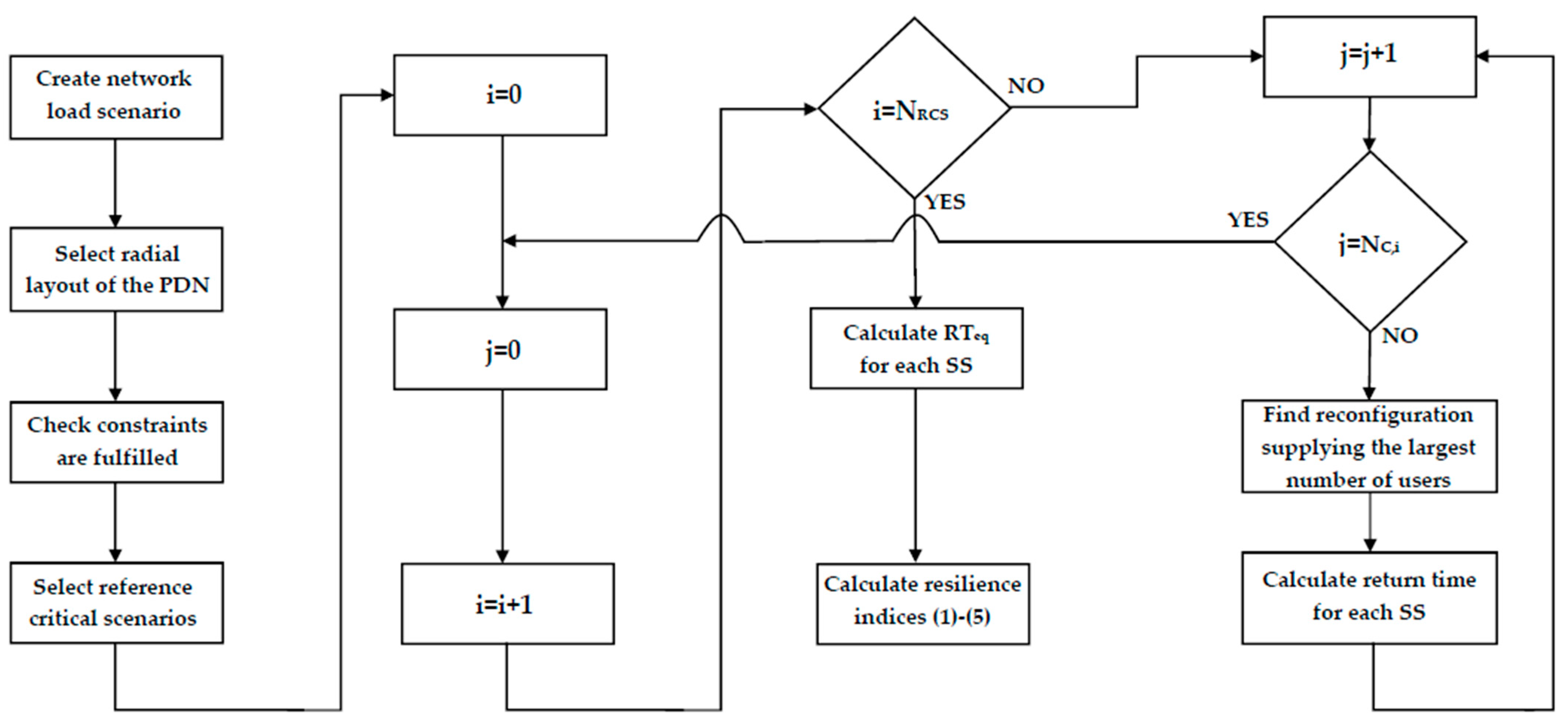
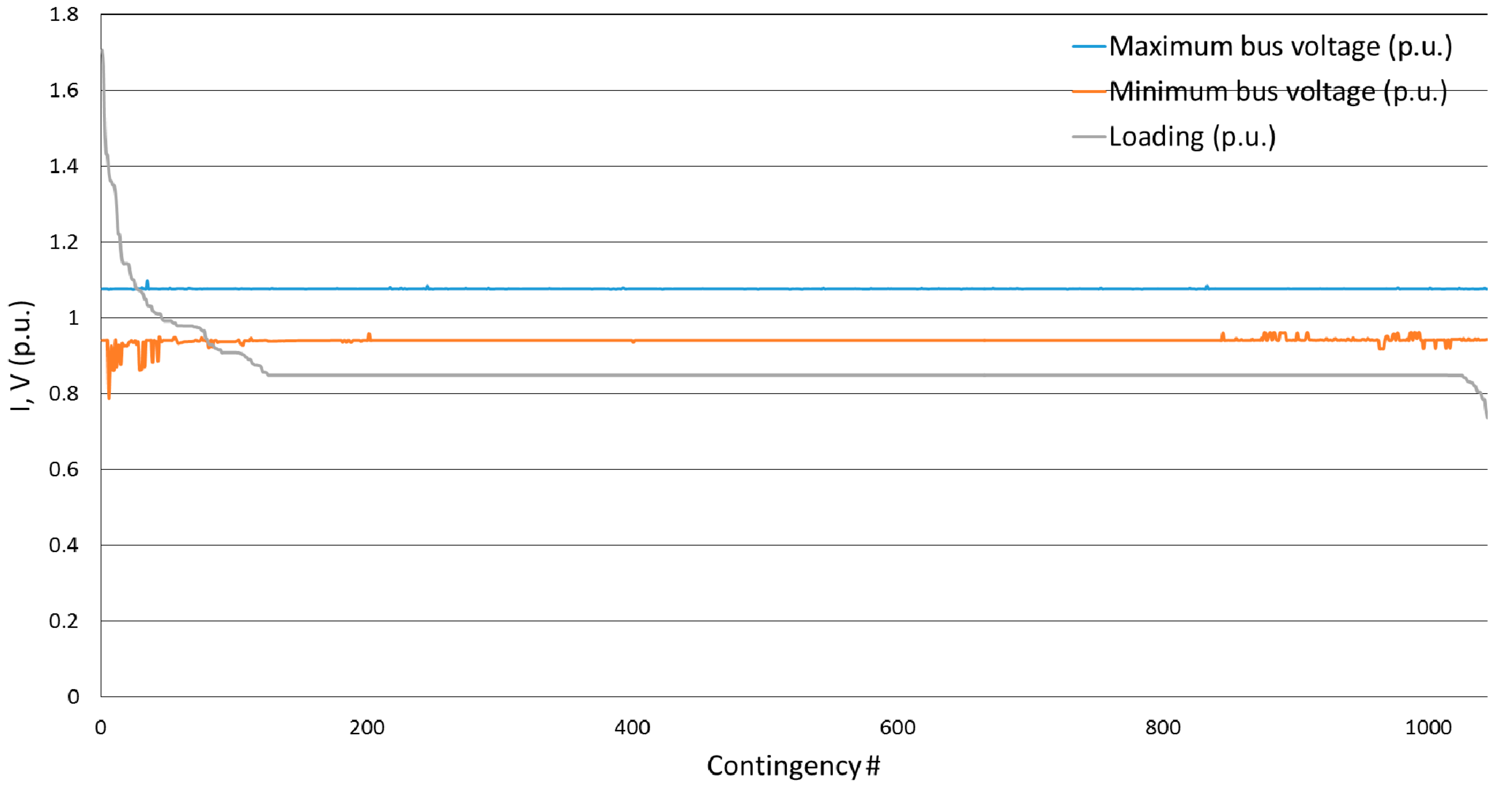

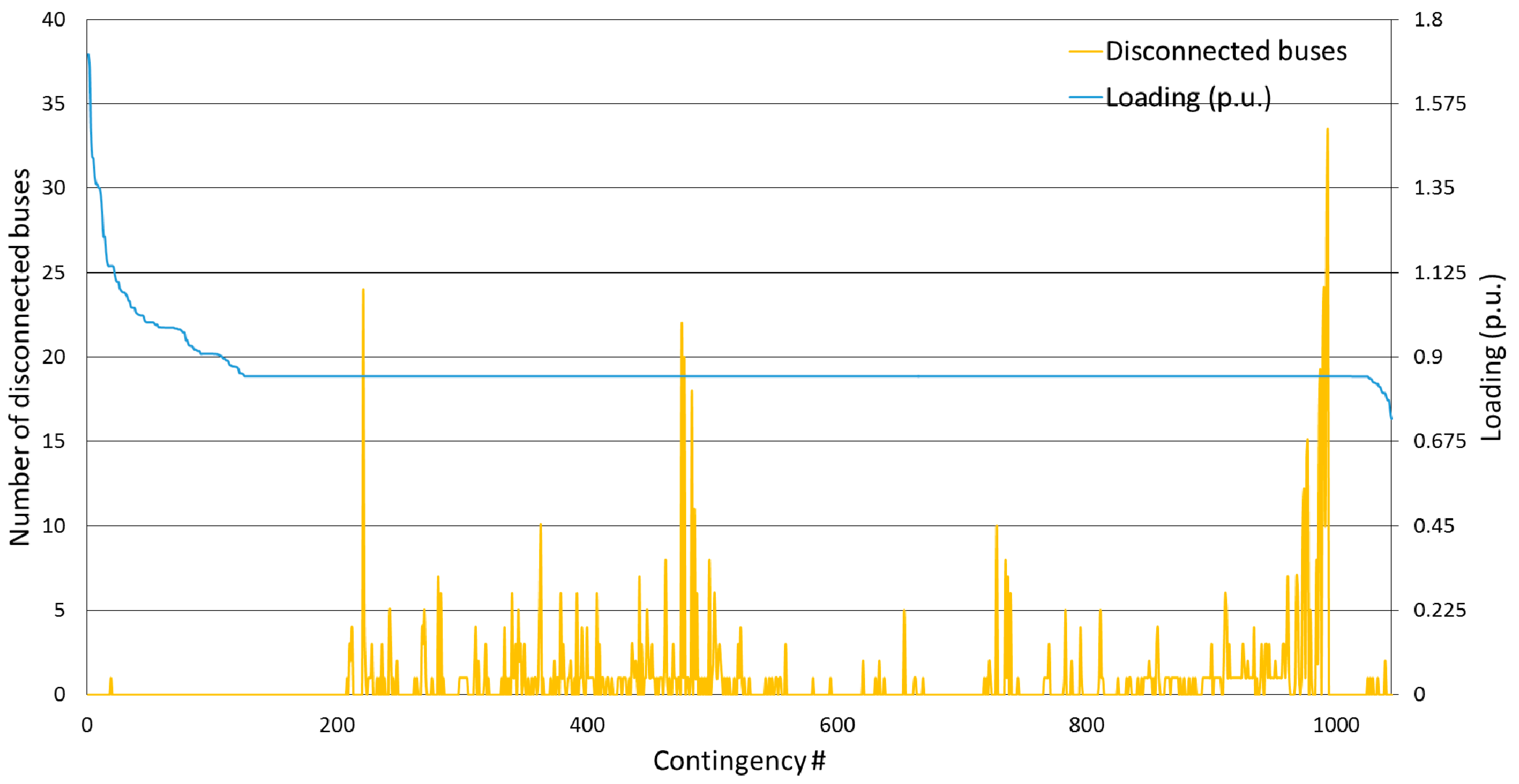

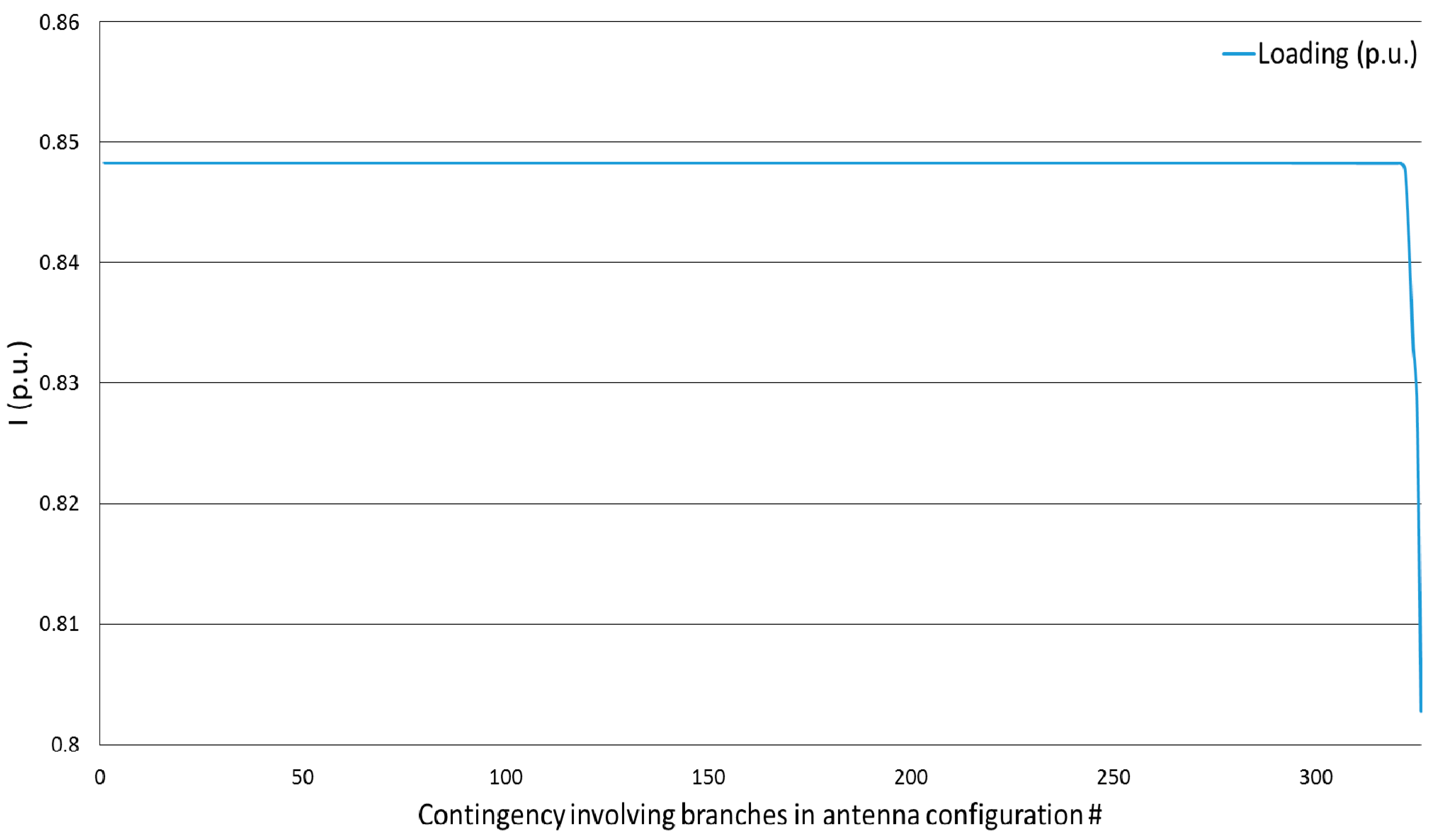

| Substation Typology | Fragility |
|---|---|
| Type 1 | 0.25 |
| Type 2 | 0.75 |
| Type 3 | 0.25 |
| Type 4 | 0.5 |
| Type 5 | 0.25 |
| Type 6 | 0.5 |
| Type 7 | 0.25 |
| MVP Typology | Fragility |
|---|---|
| Type 1 | 0.4 |
| Type 2 | 0.7 |
| Type 3 | 0.9 |
| Substation Typology | MVP Typology | ||
|---|---|---|---|
| Type 1 | Type 2 | Type 3 | |
| Type 1 | 177.99 | 101.71 | 79.11 |
| Type 2 | 59.33 | 33.91 | 26.36 |
| Type 3 | 177.99 | 101.71 | 79.11 |
| Type 4 | 88.99 | 50.85 | 39.55 |
| Type 5 | 177.99 | 101.71 | 79.11 |
| Type 6 | 88.99 | 50.85 | 39.55 |
| Type 7 | 177.99 | 101.71 | 79.11 |
| Index | Case A | Case B |
|---|---|---|
| INGR | 0.989 | 0.982 |
| INR | 0.829 | 0.327 |
| IUV | 0.390 | 3.930 |
Publisher’s Note: MDPI stays neutral with regard to jurisdictional claims in published maps and institutional affiliations. |
© 2021 by the authors. Licensee MDPI, Basel, Switzerland. This article is an open access article distributed under the terms and conditions of the Creative Commons Attribution (CC BY) license (https://creativecommons.org/licenses/by/4.0/).
Share and Cite
Cresta, M.; Gatta, F.M.; Geri, A.; Maccioni, M.; Paulucci, M. Resilience Assessment in Distribution Grids: A Complete Simulation Model. Energies 2021, 14, 4303. https://doi.org/10.3390/en14144303
Cresta M, Gatta FM, Geri A, Maccioni M, Paulucci M. Resilience Assessment in Distribution Grids: A Complete Simulation Model. Energies. 2021; 14(14):4303. https://doi.org/10.3390/en14144303
Chicago/Turabian StyleCresta, Massimo, Fabio Massimo Gatta, Alberto Geri, Marco Maccioni, and Marco Paulucci. 2021. "Resilience Assessment in Distribution Grids: A Complete Simulation Model" Energies 14, no. 14: 4303. https://doi.org/10.3390/en14144303
APA StyleCresta, M., Gatta, F. M., Geri, A., Maccioni, M., & Paulucci, M. (2021). Resilience Assessment in Distribution Grids: A Complete Simulation Model. Energies, 14(14), 4303. https://doi.org/10.3390/en14144303







